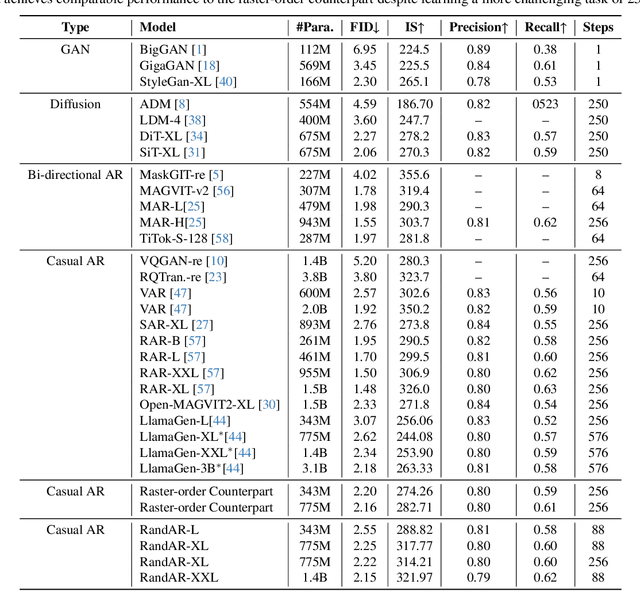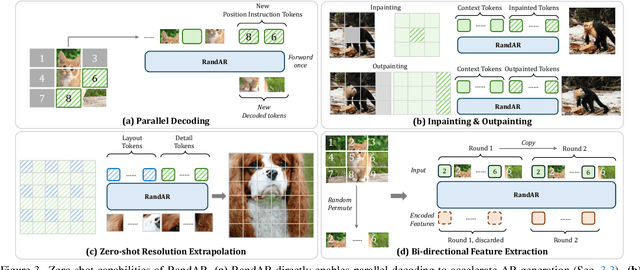Fujun Luan
Gaussian Mixture Flow Matching Models
Apr 07, 2025Abstract:Diffusion models approximate the denoising distribution as a Gaussian and predict its mean, whereas flow matching models reparameterize the Gaussian mean as flow velocity. However, they underperform in few-step sampling due to discretization error and tend to produce over-saturated colors under classifier-free guidance (CFG). To address these limitations, we propose a novel Gaussian mixture flow matching (GMFlow) model: instead of predicting the mean, GMFlow predicts dynamic Gaussian mixture (GM) parameters to capture a multi-modal flow velocity distribution, which can be learned with a KL divergence loss. We demonstrate that GMFlow generalizes previous diffusion and flow matching models where a single Gaussian is learned with an $L_2$ denoising loss. For inference, we derive GM-SDE/ODE solvers that leverage analytic denoising distributions and velocity fields for precise few-step sampling. Furthermore, we introduce a novel probabilistic guidance scheme that mitigates the over-saturation issues of CFG and improves image generation quality. Extensive experiments demonstrate that GMFlow consistently outperforms flow matching baselines in generation quality, achieving a Precision of 0.942 with only 6 sampling steps on ImageNet 256$\times$256.
WorldPrompter: Traversable Text-to-Scene Generation
Apr 02, 2025Abstract:Scene-level 3D generation is a challenging research topic, with most existing methods generating only partial scenes and offering limited navigational freedom. We introduce WorldPrompter, a novel generative pipeline for synthesizing traversable 3D scenes from text prompts. We leverage panoramic videos as an intermediate representation to model the 360{\deg} details of a scene. WorldPrompter incorporates a conditional 360{\deg} panoramic video generator, capable of producing a 128-frame video that simulates a person walking through and capturing a virtual environment. The resulting video is then reconstructed as Gaussian splats by a fast feedforward 3D reconstructor, enabling a true walkable experience within the 3D scene. Experiments demonstrate that our panoramic video generation model achieves convincing view consistency across frames, enabling high-quality panoramic Gaussian splat reconstruction and facilitating traversal over an area of the scene. Qualitative and quantitative results also show it outperforms the state-of-the-art 360{\deg} video generators and 3D scene generation models.
MegaSynth: Scaling Up 3D Scene Reconstruction with Synthesized Data
Dec 18, 2024



Abstract:We propose scaling up 3D scene reconstruction by training with synthesized data. At the core of our work is MegaSynth, a procedurally generated 3D dataset comprising 700K scenes - over 50 times larger than the prior real dataset DL3DV - dramatically scaling the training data. To enable scalable data generation, our key idea is eliminating semantic information, removing the need to model complex semantic priors such as object affordances and scene composition. Instead, we model scenes with basic spatial structures and geometry primitives, offering scalability. Besides, we control data complexity to facilitate training while loosely aligning it with real-world data distribution to benefit real-world generalization. We explore training LRMs with both MegaSynth and available real data. Experiment results show that joint training or pre-training with MegaSynth improves reconstruction quality by 1.2 to 1.8 dB PSNR across diverse image domains. Moreover, models trained solely on MegaSynth perform comparably to those trained on real data, underscoring the low-level nature of 3D reconstruction. Additionally, we provide an in-depth analysis of MegaSynth's properties for enhancing model capability, training stability, and generalization.
EP-CFG: Energy-Preserving Classifier-Free Guidance
Dec 13, 2024



Abstract:Classifier-free guidance (CFG) is widely used in diffusion models but often introduces over-contrast and over-saturation artifacts at higher guidance strengths. We present EP-CFG (Energy-Preserving Classifier-Free Guidance), which addresses these issues by preserving the energy distribution of the conditional prediction during the guidance process. Our method simply rescales the energy of the guided output to match that of the conditional prediction at each denoising step, with an optional robust variant for improved artifact suppression. Through experiments, we show that EP-CFG maintains natural image quality and preserves details across guidance strengths while retaining CFG's semantic alignment benefits, all with minimal computational overhead.
Turbo3D: Ultra-fast Text-to-3D Generation
Dec 05, 2024



Abstract:We present Turbo3D, an ultra-fast text-to-3D system capable of generating high-quality Gaussian splatting assets in under one second. Turbo3D employs a rapid 4-step, 4-view diffusion generator and an efficient feed-forward Gaussian reconstructor, both operating in latent space. The 4-step, 4-view generator is a student model distilled through a novel Dual-Teacher approach, which encourages the student to learn view consistency from a multi-view teacher and photo-realism from a single-view teacher. By shifting the Gaussian reconstructor's inputs from pixel space to latent space, we eliminate the extra image decoding time and halve the transformer sequence length for maximum efficiency. Our method demonstrates superior 3D generation results compared to previous baselines, while operating in a fraction of their runtime.
MaterialPicker: Multi-Modal Material Generation with Diffusion Transformers
Dec 04, 2024



Abstract:High-quality material generation is key for virtual environment authoring and inverse rendering. We propose MaterialPicker, a multi-modal material generator leveraging a Diffusion Transformer (DiT) architecture, improving and simplifying the creation of high-quality materials from text prompts and/or photographs. Our method can generate a material based on an image crop of a material sample, even if the captured surface is distorted, viewed at an angle or partially occluded, as is often the case in photographs of natural scenes. We further allow the user to specify a text prompt to provide additional guidance for the generation. We finetune a pre-trained DiT-based video generator into a material generator, where each material map is treated as a frame in a video sequence. We evaluate our approach both quantitatively and qualitatively and show that it enables more diverse material generation and better distortion correction than previous work.
RandAR: Decoder-only Autoregressive Visual Generation in Random Orders
Dec 02, 2024



Abstract:We introduce RandAR, a decoder-only visual autoregressive (AR) model capable of generating images in arbitrary token orders. Unlike previous decoder-only AR models that rely on a predefined generation order, RandAR removes this inductive bias, unlocking new capabilities in decoder-only generation. Our essential design enables random order by inserting a "position instruction token" before each image token to be predicted, representing the spatial location of the next image token. Trained on randomly permuted token sequences -- a more challenging task than fixed-order generation, RandAR achieves comparable performance to its conventional raster-order counterpart. More importantly, decoder-only transformers trained from random orders acquire new capabilities. For the efficiency bottleneck of AR models, RandAR adopts parallel decoding with KV-Cache at inference time, enjoying 2.5x acceleration without sacrificing generation quality. Additionally, RandAR supports inpainting, outpainting and resolution extrapolation in a zero-shot manner. We hope RandAR inspires new directions for decoder-only visual generation models and broadens their applications across diverse scenarios. Our project page is at https://rand-ar.github.io/.
Buffer Anytime: Zero-Shot Video Depth and Normal from Image Priors
Nov 26, 2024Abstract:We present Buffer Anytime, a framework for estimation of depth and normal maps (which we call geometric buffers) from video that eliminates the need for paired video--depth and video--normal training data. Instead of relying on large-scale annotated video datasets, we demonstrate high-quality video buffer estimation by leveraging single-image priors with temporal consistency constraints. Our zero-shot training strategy combines state-of-the-art image estimation models based on optical flow smoothness through a hybrid loss function, implemented via a lightweight temporal attention architecture. Applied to leading image models like Depth Anything V2 and Marigold-E2E-FT, our approach significantly improves temporal consistency while maintaining accuracy. Experiments show that our method not only outperforms image-based approaches but also achieves results comparable to state-of-the-art video models trained on large-scale paired video datasets, despite using no such paired video data.
Baking Gaussian Splatting into Diffusion Denoiser for Fast and Scalable Single-stage Image-to-3D Generation
Nov 21, 2024



Abstract:Existing feed-forward image-to-3D methods mainly rely on 2D multi-view diffusion models that cannot guarantee 3D consistency. These methods easily collapse when changing the prompt view direction and mainly handle object-centric prompt images. In this paper, we propose a novel single-stage 3D diffusion model, DiffusionGS, for object and scene generation from a single view. DiffusionGS directly outputs 3D Gaussian point clouds at each timestep to enforce view consistency and allow the model to generate robustly given prompt views of any directions, beyond object-centric inputs. Plus, to improve the capability and generalization ability of DiffusionGS, we scale up 3D training data by developing a scene-object mixed training strategy. Experiments show that our method enjoys better generation quality (2.20 dB higher in PSNR and 23.25 lower in FID) and over 5x faster speed (~6s on an A100 GPU) than SOTA methods. The user study and text-to-3D applications also reveals the practical values of our method. Our Project page at https://caiyuanhao1998.github.io/project/DiffusionGS/ shows the video and interactive generation results.
Generating 3D-Consistent Videos from Unposed Internet Photos
Nov 20, 2024



Abstract:We address the problem of generating videos from unposed internet photos. A handful of input images serve as keyframes, and our model interpolates between them to simulate a path moving between the cameras. Given random images, a model's ability to capture underlying geometry, recognize scene identity, and relate frames in terms of camera position and orientation reflects a fundamental understanding of 3D structure and scene layout. However, existing video models such as Luma Dream Machine fail at this task. We design a self-supervised method that takes advantage of the consistency of videos and variability of multiview internet photos to train a scalable, 3D-aware video model without any 3D annotations such as camera parameters. We validate that our method outperforms all baselines in terms of geometric and appearance consistency. We also show our model benefits applications that enable camera control, such as 3D Gaussian Splatting. Our results suggest that we can scale up scene-level 3D learning using only 2D data such as videos and multiview internet photos.
 Add to Chrome
Add to Chrome Add to Firefox
Add to Firefox Add to Edge
Add to Edge